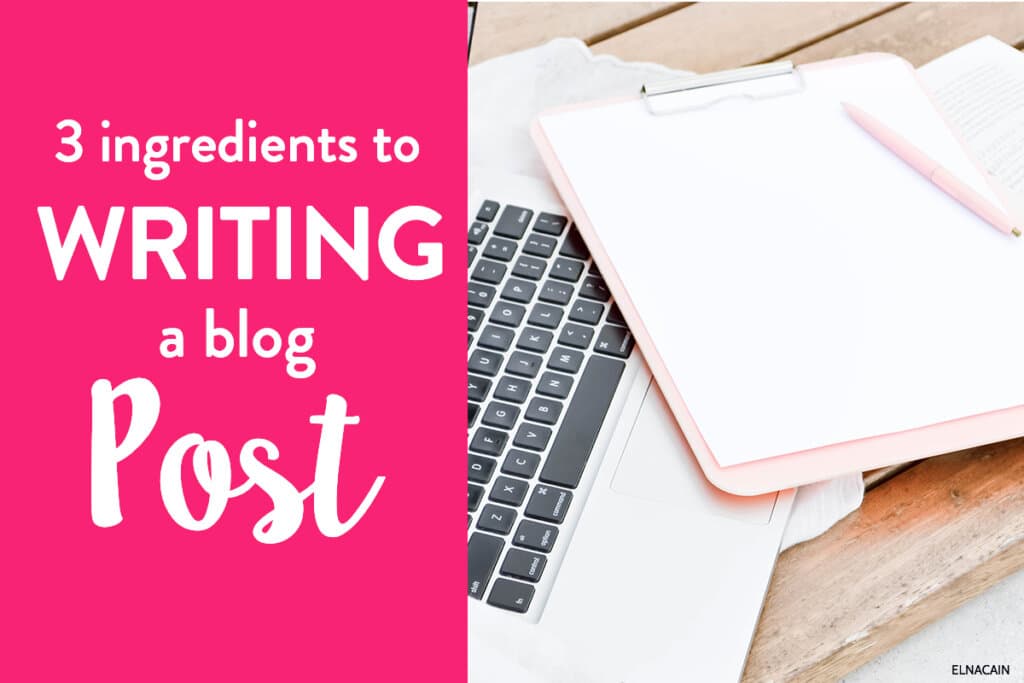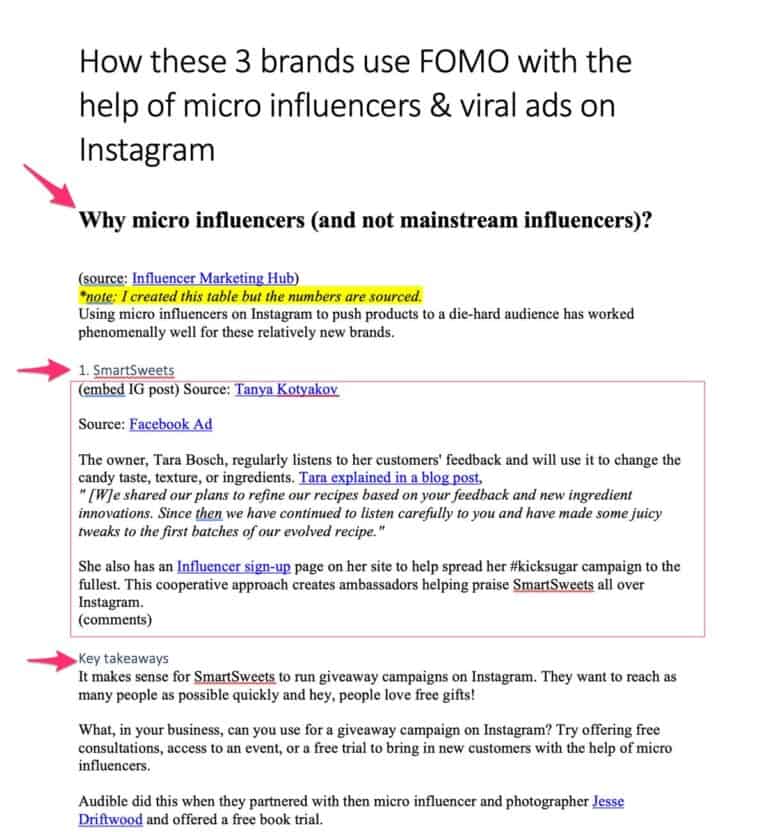Okay. You just finished writing your blog post and hit SUBMIT.
Now you tweet it, share it on LinkedIn, Pinterest, Google+, Facebook and wait.
Nothing. No one is biting.

Why is no one is talking about your wonderful best blog post?
I mean you’ve spent time figuring out what to call your blog post, used examples to improve your content, used an awesome photo and even linked to other sites and old blog posts of yours.
If you’re one of many who started a blog and is wondering why no one wants a taste of your content, maybe you are missing a key ingredient, which is how to write a blog post outline.
Yes, a blog post outline when you’re a new freelance writer doesn’t have to be hard.
Find out how to write a blog post outline so that you have a blog post that every reader can’t resist.
Writing a Blog Post Outline the Right Way
When writing a blog post outline, the thing to remember is that you can always go back to your blog posts and change them.
Nothing is set in stone.
When I write a blog post outline for a client, I constantly rearrange my subtopics and move things around until I’m satisfied with my blog outline.
As well, if you start a blog and write blog posts on your own blog, you can go back at any time and change your blog post. I usually go back to old blog posts and add more because after years of making money writing, I have learned a thing or two to improve my writing.
Let’s go through some blog formatting and writing process ideas to help you with your blog post outline.
1. Blog Format: Easy to Read Blog Paragraphs
One of the biggest mistakes new writers make when writing a blog post is blogging like they are writing a paper for their college professor.
Growing up, we learned that a proper paragraph is 5-6 sentences and that it should always include a topical sentence on what you will be writing.
If you write like this on your blog, don’t expect your readers to stick around. Only 16% of readers actually read word for word.
That means 84% of your readers only scan your entire blog post that you so painstakingly poured over for hours. To gain more readers, make it easy for them to scan by using these bite sized tips:
- Break up your paragraphs throughout your blog post. Make a break after 2-3 sentences. Mix up your paragraph lengths and sometimes stick a 1 sentence paragraph in your post.
- To break up your writing, try to include bullets and numbered lists (do you notice how I did this with my blog post? If I were to just make these into sentences my post would seem long and boring to read).
- Use attractive headings in your blog. Brian Clark, the owner of Copyblogger, wrote to make your scanners into readers, you need to lure them into reading the next sentence. You can do this effectively by using headings that will highlight the benefit of what they will be reading next.
2. Write a Blog Post With Clarity
When writing a blog post, it can have the most profound piece of information that everyone needs to read, but no one is reading it because of how it’s written.
You don’t understand because you made sure to edit for spelling, grammar, length, and redundancies.
No matter how long you spend checking over your blog post, you could be missing simple things to make your readers want to nibble away at what you wrote.
Take a look to see if you are using these extra toppings to enhance your blog post.
1. Deliciously Decorate Your Blog Post With Bold Text
When you bold key words or phrases, it helps draw the eye to important information in your blog post.
It also helps the 84% of readers who scan by giving them the most important information in headings and bold text.
If you are a scanner, you’re probably only reading the headings and nothing more. At least with bold phrases, you can be alerted to informative content.
2. Cut Away Clichés to Make Room for Metaphors
What are clichés? They are sayings that automatically come to your head when you are writing and usually appear when you can’t think of anything else to say.
They bore us because we’ve heard them used too many times, but as a writer, it can sometimes be hard to think of original content and you may not even know you’re using them.
Here are 10 clichés to avoid:
- Begs the question
- At the end of the day
- Moving forward
- As I’m sure you know
- Been there, done that
- Busy as a bee
- A little late in the game
- A twinkle in (his,her) eye
- Moral of the story
- I couldn’t care less
If you want your readers grabbing for more of your writing, try using metaphors instead.
Metaphors use parallel ideas to help get your topic better understood. They are often used for complicated ideas or as a way to spin an old idea in a new way.
Let’s use my blog post as an example.
My overall idea, how to write a blog post, is an old topic that has been written about and spun many ways. I focused on making your blog post memorable and sharable. From there, I wanted to use a metaphor to give this old topic a fresh perspective. I decided to use food as a way to describe how to write a memorable blog post.
3. Make It A Simple Dish To Read
There are many topics you can write about but if you’re using technical jargon and big words, you may be losing readers.
It’s important to know your audience before you begin to write your post. If you are writing about the latest fashion trends then using college level writing won’t attract the right audience.
Similarly, if your blog is about mental health issues in women, using slang would be inappropriate for your reader base.
Generally, keep your blog simple and if you need to write about something more technical, you can always use metaphors!
3. Make Each Blog Post Highly Valuable
Everyone who is a blogger wants some sticky content when writing a blog post. It’s a post that gets shared on multiple social platforms and gets readers to keep coming back for more of what you are serving. How can you make your blog post oh so sweet and sticky?
1. Provide Helpful Content
If all you write about is how your cat spends his days with you, people won’t be interested. They aren’t learning anything new from your blog posts.
When you solve problems and present new ideas or old ideas in a new way, readers will get value out of your blog.
Always think, how can I add something new for my readers that they will learn from?
2. Engage With Your Readers
Darren Rowse, owner of Problogger, wrote about his wife’s new website and was pleasantly surprised by how she was able to gain a following. She did this by starting a conversation with her readers.
She always:
- Answered any comments left on her blog or social media accounts. This lets her readers know she heard them and that she values their input.
- Always ends her blog post with a call to action. It’s a question or action plan for your readers. It invites a conversation and is considered good blogging etiquette.
Another way to make your blog posts engaging to your readers is by being personal.
As a freelance writer, I want other new freelance writers to learn from my content, but also a little more about who I am and why I chose this profession. That’s why on my blog I write about myself and my career along with how to improve your writing.
How to Write a Blog Post Outline
Here’s how to write a blog post outline: a simple formula to follow.
1. Headline
You’re headline is one of the most important pieces in learning how to make an outline for your content pieces.
You need a headline that can grab the attention of scanners on social media. The attention span is only 2 seconds long!
Ouch!
You only have two seconds for people to read your headline. Some tips:
- Have the most important words in the front of your headline
- Use numbers as this gets people excited for lists
- Use odd numbers. For some reason people like odd numbers
- Use superlatives like Best, Worst, etc..
- Add emotional based words like: Ridiculous, proven, simple, easy, etc.
For more help, check out my video on creating copywriting headlines:
2. Subtopics
Next in how to write an outline for a blog post is to think about the body of the blog post or your subtopics.
This is the main part of your blog post and what clients want out of a writer.
This shows your credibility in your writing skills as well as your knowledge of the topic/industry at hand.
As I mentioned, I take my time writing my subtopics for my freelance writing work.
Here’s an outline I created for a client of mine.

The arrows in my image are the subtopics I came up with. This will not be the final outline but it’s my working blog post outline.
3. Siting Sources
One thing I do in my outline template is to also add or site my sources.
I generally do my reteach alongside making my blog post outline so I just add them to my outline (the red box).
Learning how to research for your freelance writing job is an important skill to have.
4. Write the Post and Use Grammarly
Once I have my blog post outline created, I get to work on writing the introduction.
I have a top-down writing process, which means I have to start at the beginning.
Other writers might write the subtopics first and the intro/conclusion last. I cannot do that!
Once the post is written, I then use Grammarly to edit my content.
How to Write a Blog Post Outline
There ya go!
Interested in becoming a freelance writer? My course Write Your Way to Your First $1k goes into great detail about blog writing and formatting your posts for your clients. Wow your clients and enroll in my course today!
Is there any more bite sized tips I have forgotten?
Hs this post on making a blog post outline helpful? Please share your answers in the comments!




48 Comments